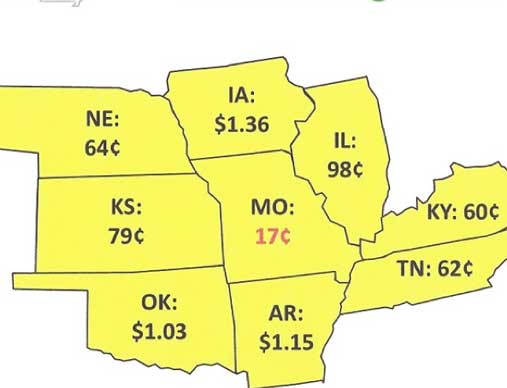
The Kansas City Health Commission contends that Missouri’s low cigarette tax results in more children smoking and discourages surrounding states from raising their rates. Graphic courtesty Kansas City Missouri Health Department.
Missouri voters last month narrowly rejected higher taxes on cigarettes, but the issue still burns in the state with the nation’s lowest tax on smokes.
A new pre-filed bill in the Missouri Senate would raise the tax from the 17 cents a pack in effect for almost two decades to 43 cents a pack.
That is less than the raise to 90 cents per pack that voters rejected, but it and other tobacco battles are already taking shape.
Last week, the Kansas City Health Commission’s Tobacco Use Reduction Committee reported to the city council that among its top goals is stopping preemption. That is a strategy in which the tobacco industry pushes for state laws that forbid cities from having harsher laws than the state.
A proposal to allow preemption did not get out of committee in Missouri this year but is expected to return next year.
If it succeeds, as it has in some other states, it could overturn a Kansas City law approved by voters four years ago that forbids smoking in bars and restaurants, said Rex Archer, city health director.
He said this week that the industry spends big to stop any increase in cigarette taxes in Missouri because its super low rate – “we like to use the term dead last” – discourages the many adjacent states from increasing their rates.
Archer said Kansas and the other states fear that if they raise the taxes, smokers will just drive to Missouri to get cigarettes.
The tax rate is important because the higher cost reduces the number of children who start smoking, he said.
The new proposal to raise Missouri taxes to 43 cents a pack “would reduce the number of kids starting, not a lot, but it would make some progress,” Archer said.
While all the fighting continues, officials reported last week, smoking continues to addict and kill.
Education and prevention about this are also part of the health commission effort, officials reported.
Among numbers they cited last week:
- About 90 percent of smokers begin before age 18, and about 18 percent of high school students smoke.
- At the current rate of smoking, which is about 20 percent for adults, more than 6.3 million children under 18 today will eventually die of smoking-related disease.



Who’s talking